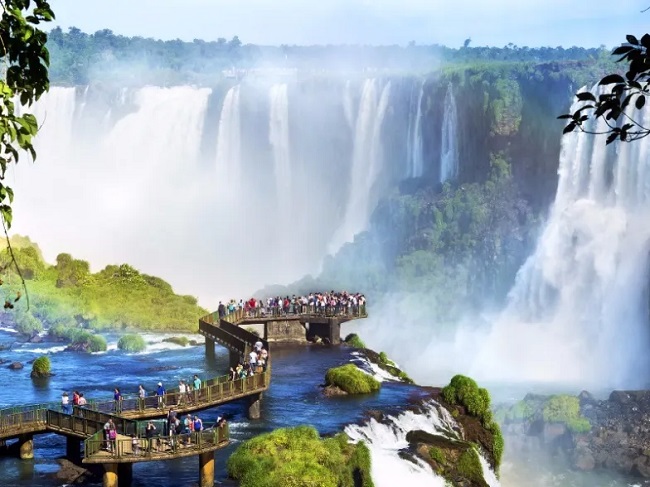Vibrant, bold, and beautiful, Argentina lures with its vibrant cities, fiery culture, and abundance of natural wonders. Argentina is more than just the birthplace of the tango.
A Mesmerising international inventiveness seeps out of the many cafés and street side hangouts along the cobbled European-style streets of buzzing Buenos Aires. Cordoba, a city rich in Spanish architecture, and Mendoza, in the heart of Argentina’s wine country, are two examples.

Top 10 Places to Visit in Argentina
Nature and animal attractions in Argentina are conveniently located throughout the country. Iguaz Falls is a spectacular waterfall in the subtropical north of Argentina, and the area around it is great for hiking.
Penguins and beautiful glaciers await visitors to El Glaciares National Park in Patagonia. Seeing a Southern Right Whale in the wild is a highlight of any trip to the Golfo Nuevo. Use our recommended Argentina destinations to help you organise your vacation to this fascinating country.
1. Quebrada de Humahuaca
The Quebrada de Humahuaca is a dry and underappreciated mountain valley in the Jujuy province of northwestern Argentina. Its history dates back thousands of years. Its accessible caravan road was an integral part of an old Inca commercial route and contributed to the city’s fame during its heyday.
Cacti, lamas, rough mountains, and colourful sandstone escarpments form the landscape of the valley. Humahuaca, the valley’s namesake and largest settlement, is home to slightly over 10,000 people. Other, less well-known mountain villages, such as Iruya and Purmamarca, are also located in the area and are home to authentic, quaint communities and a wonderful market.
The mountain scenery of the Quebrada (which means “broken”) is very spectacular, especially the Sierra de Siete Colores with its unforgettable rainbow-colored hills, which are surrounded by the Sub-Andean hills to the east, the Altiplano to the west, and the Valles Templados to the south.
The Quebrada de Humahuaca valley was the scene of several fierce engagements during the Argentine War of Independence and is a must-see for history buffs. Tilcara’s mediaeval fortress is also well worth seeing. The old splendour of this historic Incan site has been brought back.
2. Cordoba
Cordoba, the second largest city in Argentina, sits smack dab in the middle of the country. The city’s many educational institutions contributed to its nickname, “the Learned” (La Docta). Located on the Primero River and framed by three mountain ranges, Cordoba is home to stunning examples of both traditional colonial architecture and cutting-edge construction.
Specifically, the Jesuit churches built there in the 17th century. Because more than 200,000 students call Cordoba home, the city has a surprisingly vibrant nightlife and a crammed social calendar full with cuarteto music and rally car racing.
Immersing oneself in Cordoba’s culture is a great way to feel the city’s vibe. The city has several different options for entertainment, including theatres, museums, and arte pubs.
3. Puerto Madryn
The settlement of Puerto Madryn on the coast of Gulfo Nuevo is widely recognised as the starting point for excursions to Peninsula Valdes. Beautiful beaches draw many people there every summer, despite the water’s chill.
Madryn’s population has grown rapidly in recent years thanks to an increase in tourism, and the small year-round population is dwarfed by the influx of seasonal visitors in the summer.
Because the Southern Right Whale prefers Gulfo Nuevo for breeding and giving birth, whale watching cruises are also very common. The whales are close enough to the coast to be seen from the mainland from July through September.
The mushroom-shaped Peninsula Valdes protrudes into the South Atlantic and is only connected to the main land by a narrow isthmus. Seals, penguins, orcas, and sea lions, among other fascinating marine species, all make the peninsula their home for at least part of the year.
Around 180 different bird species have been spotted on this headland, making it a prime location for bird watchers. The Snowy Sheathbill, Patagonian Canastero, and Rusty-backed Monjita are just a few of the migratory birds you should keep an eye out for if you bring your binoculars.
Puerto Piramides, a little town, and a few ranches are all that can be found on the peninsula. There are two main roads in the hamlet, each of which features a market, souvenir stores, and a number of excellent restaurants serving locally caught seafood. A small number of bars offer alcoholic beverages, live music, and a place to socialise.
It’s important to know that Peninsula Valdes is privately owned and so off-limits to visitors. Tour providers in the nearby city of Puerto Madryn should be contacted to organise all trips to the peninsula. Bus and boat cruises fall under this category.
4. Bariloche
San Carlos de Bariloche, generally known as Bariloche, is a charming city in Argentina’s lake district that is perched on the slopes of Cerro Otto. The views from Bariloche are really breathtaking, as they gaze out over the royal blue waters of Lake Nahuel Huapi and the avocado-colored slopes of the surrounding mountains in Park Nacional Nahuel Huapi.
The town has its own beach because of its great location on the lake, although it is quite modest and not the main attraction. Bariloche, on the other hand, is a popular tourist destination because of the abundance of outdoor recreation activities it provides, including skiing, hiking, rock climbing, and even water sports.
In the winter, the town transforms into a charming ski resort reminiscent of a Swiss village. San Carlos de Bariloche, Argentina is a winter wonderland that features the Cerro Catedral ski resort and numerous Argentinian chocolate shops and breweries.
The Seven Lakes Route to the north of the city gives beautiful vistas of the lakes and mountains, while to the west of Bariloche are stunning waterfalls and glaciers in Pampa Lenda. The lakes are great for fishing in the summer, and the beaches are packed with swimmers, sunbathers, and people enjoying other water activities.
5. Ushuaia
Ushuaia is the capital of Argentina’s Tierra del Fuego region and a major departure point for Antarctica cruises. Its location within the Beagle Strait gives rise to the city’s moniker, “End of the World,” as it is one of the most southernly populated areas on Earth.
Although it is rather out of the way, Ushuaia has become a famous tourist destination because to its many casinos and expensive hotels. Once you start digging, though, you’ll find that this city was previously an exile prison and an Argentine naval base.
Fagnano Lake and numerous scenic hiking paths may be found to the east of the city, while Tierra del Fuego National Park and the End of the World Railway can be located to the west. The Beagle Channel is a great place to see sea lions and penguins.
Nearer to the heart of the city, there is much to explore as well. The serene snow-capped Martial Glacier provides a breathtaking vantage point over the city, and the Maritime and Old Prison Museum, with its haunting jail cells, is a must-see.
6. Mendoza
Mendoza is a famous tourist destination not only because it is located in the heart of Latin America’s wine country, but also because it is so close to Aconcagua, the tallest mountain in the Americas. Hiking, horseback riding, river rafting, and other outdoor activities are all available in the surrounding area of Mendoza.
Independence Square, the city’s central plaza, is lined by attractively lit restaurants, stores, and buildings at night. What makes Mendoza an exceptional place to produce wine is atypical.
Mendoza is a wide desert region, however the region is kept adequately irrigated by a unique irrigation system. These unmanmade rivers are located on both sides of the road and are connected by pedestrian and vehicle bridges.
Wine tours and tastings are offered often at many Mendoza region bodegas. Private tastings with the estate sommelier and bike tours are just two of the unique activities available at each winery.
Many wineries provide tours that you can join without making reservations, so you can come whenever it suits you. Plan ahead if you want to visit a winery in Mendoza, as they are generally filled up weeks in advance during the harvest months of March and April.
7. El Chalten
El Chaltén, in the Patagonian region of southern Argentina, is a charming frontier hamlet that was founded as an outpost in the late 1970s. This picturesque tiny community is a popular starting point for hiking, mountain biking, and trekking experiences due to its proximity to two of Patagonia’s most remarkable peaks: Mount Fitz Roy and Cerro Torres. In the summer, the city swells to capacity with visitors.
The town of El Chaltén is a great place to start exploring Los Glaciares National Park’s northern region. Which one you select is entirely up to you.
Easy hikers can visit the secluded Lake del Desierto, while those seeking a more strenuous adventure can take on the lengthier journey to Laguna de los Tres or Laguna Torre. Following a day of hiking, locals and visitors alike flock to La Cerveceria, the village’s brewery, for a refreshing beverage.
8. Los Glaciares
Beautiful Los Glaciares National Park, also known as Glaciers National Park, is Argentina’s second-biggest park and one of the world’s largest and most accessible ice fields. Visitors may see these displays, as well as icebergs of incredible hues and patterns, up close and personal from a variety of boardwalks and boat tours.
The glaciers’ never-ending advance and retreat creates a never-ending spectacle of ice cracking and thundering booms as huge chunks break off and crash into the lakes with gigantic splashes. In the northern part of the park, away from the glaciers in the south, you’ll find magnificent mountains perfect for mountaineering and hiking, including Mount Fitz Roy.
The Perito Moreno Glacier is the main attraction in Glaciers National Park, attracting hikers and rock climbers from all over the world despite the park’s beautiful turquoise lakes and forested hills. Its constant motion creates a spectacular picture as ice floes plummet violently into the ocean below.
9. Buenos Aires
It’s no surprise that the vibrant and alluring tango dance originated in Buenos Aires, with its colourful European architecture, bustling neighbourhoods, amazing shopping, and hot nightlife. Buenos Aires is the capital of Argentina and one of the largest cities in Latin America. It is located on the southeastern coast of South America.
Theater performances, glamorous bars, fashionable art galleries, and a vibrant nightlife can all be found inside the city’s vast, French and Italian-style architecture. If you want to experience Buenos Aires to the fullest, from dinner to late-night nightlife, you won’t have much time for sleep.
Many neighbourhoods, known as barrios, make up the dynamic, multicultural city. The Microcentro, home of The Obelisco, is one of the most well-known of these neighbourhoods. Flea markets draw crowds to San Telmo, while La Boca’s brightly painted buildings and tango performances have made it a globally renowned neighbourhood.
One of the most vibrant cultural scenes in Latin America, the city is bursting at the cultural institution and world-class theatre and art gallery. Attending the tango dances that are constantly performed in different streets and places is one of the most popular things to do in Buenos Aires.
10. Iguazu Falls
Iguazu Falls, whose name means “Big Water,” is a massive waterfall in Argentina. These enormous waterfalls, which can be found on the border between Brazil and Argentina, are actually comprised of hundreds of smaller waterfalls.
Surprisingly, the tallest waterfall is almost twice as high as Niagara Falls and is called Devil’s Throat. The lush forest teeming with diverse fauna only adds to the splendour of the falls, but the falls themselves are a stunning display.
Parque Nacional Iguaz, the national park that contains the waterfall, is situated close to Puerto Iguazu and is home to some of the world’s few remaining Atlantic rainforests, as well as other wonderful plants and animals. Visitors can get wet from the falls’ spray on one of the park’s many wonderful pathways, and there are also boat rides available.
While the Iguazu Falls themselves are the main draw, visitors also come to see the diverse wildlife that calls the area home. Iguazu National Park is home to over 2,000 plant species and a wide variety of wildlife, including howler monkeys, giant anteaters, jaguars, ocelots, caymans, and more.

























